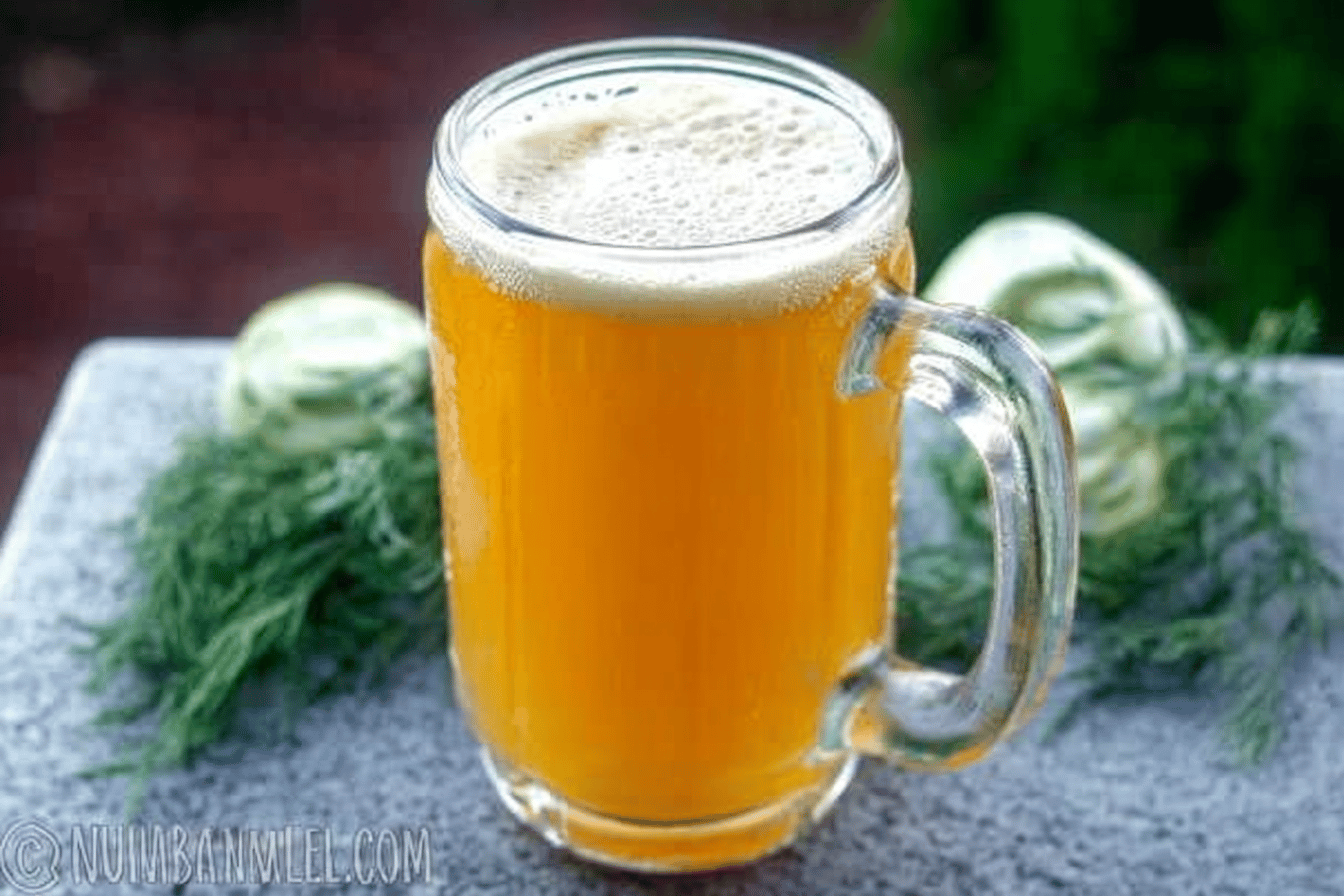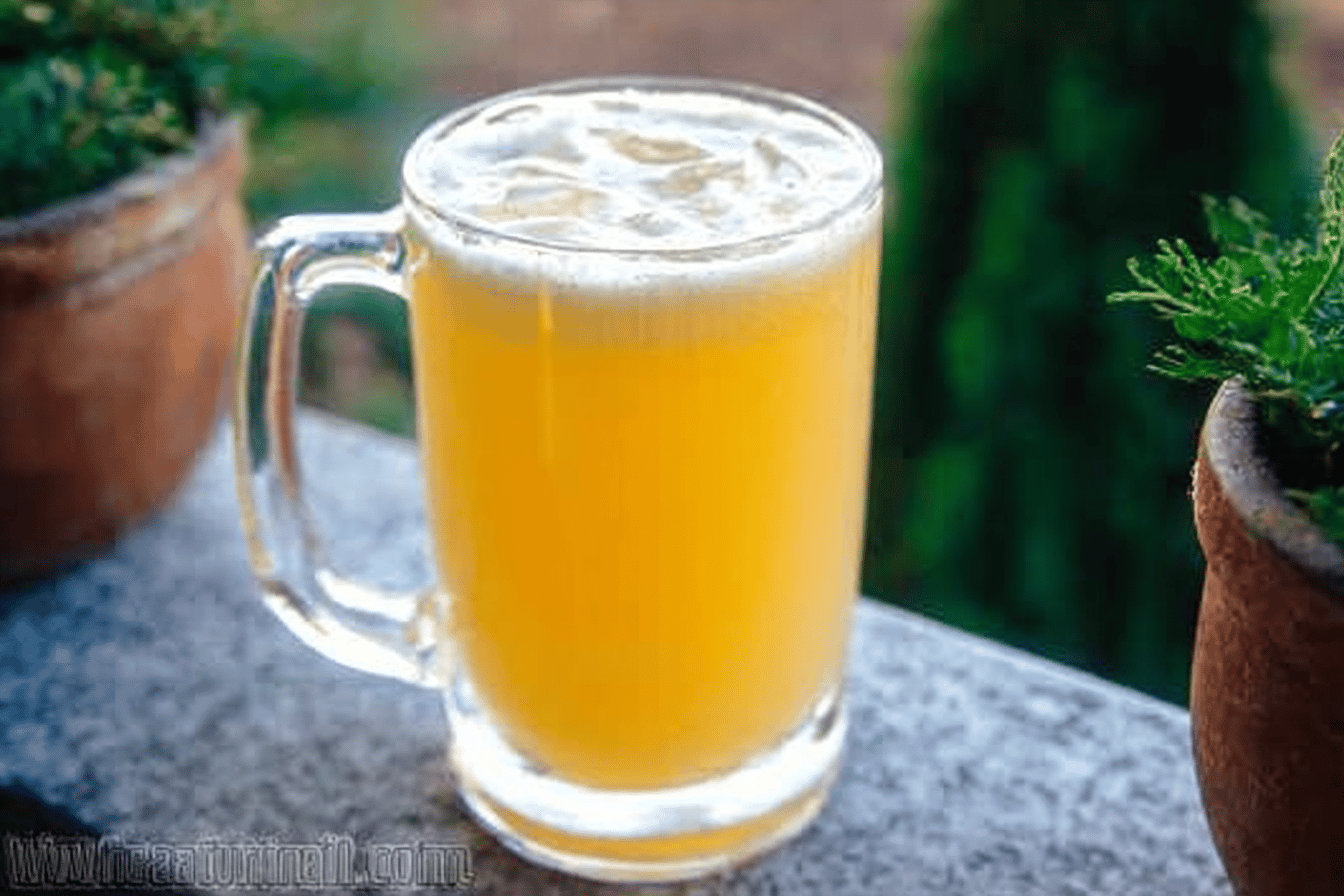Why You’ll Love This Russian Kvas Recipe
Russian Kvas Recipe is a delightful fermented drink that brings a taste of the Slavic and Baltic traditions right into your kitchen. Imagine creating a bubbly, sweet-sour beverage from simple ingredients like sourdough rye bread, sugar, and water, all through natural fermentation. It’s perfect for home cooks looking for an easy way to enjoy probiotic benefits while experimenting with flavors.
One reason you’ll love this Russian Kvas Recipe is its simplicity. It requires just a few basic items and follows straightforward steps that even beginners can master, making it ideal for busy parents or students who want a quick project with big rewards. Plus, the natural fermentation process using wild yeasts turns everyday ingredients into a refreshing drink that’s naturally bubbly and full of health perks. Whether you’re a food enthusiast or someone mindful of your diet, this recipe’s versatility lets you tweak it to fit your needs.
Another highlight is the health angle. This homemade kvass is packed with natural probiotics that support digestive health and boost immunity, thanks to the fermentation of sourdough rye bread with non-chlorinated water. It’s a low-alcohol option, typically around 0.5% to 1.0%, so you can enjoy it chilled or warm without worrying too much. For diet-conscious individuals, like vegans or those on gluten-free plans, it’s adaptable and provides antioxidants that make it a smart choice for everyday wellness.
The flavor profile is what really sets this Russian Kvas Recipe apart. That unique tangy-sweet taste comes from fermenting the bread with sugar, creating a complex drink that’s moreish and refreshing. It’s also versatile for travelers or newlyweds hosting gatherings, as you can add flavors like herbs and spices in the second fermentation. Overall, this recipe encourages joyful cooking and helps create memorable moments with family and friends around the table.
To make it even more appealing, think about how this Russian Kvas Recipe can become a staple in your routine. Baking enthusiasts might appreciate the toasted rye bread’s role, which deepens the flavor and adds a rustic touch. For working professionals, the minimal sugar left after fermentation means it’s a lighter alternative to sugary drinks. By following this guide, you’re not just making a drink you’re embracing a tradition that promotes patience and natural goodness in your daily life.
Jump To
- 1. Why You’ll Love This Russian Kvas Recipe
- 2. Essential Ingredients for Russian Kvas Recipe
- 3. How to Prepare the Perfect Russian Kvas Recipe: Step-by-Step Guide
- 4. Dietary Substitutions to Customize Your Russian Kvas Recipe
- 5. Mastering Russian Kvas Recipe: Advanced Tips and Variations
- 6. How to Store Russian Kvas Recipe: Best Practices
- 7. FAQs: Frequently Asked Questions About Russian Kvas Recipe
- 8. Russian Kvas Recipe
Essential Ingredients for Russian Kvas Recipe
When I first tried making this Russian Kvas Recipe at home, I was amazed at how a few key ingredients could create such a tasty fermented drink. The beauty lies in using fresh, simple items that are easy to find, ensuring anyone can whip up a batch. Below, I’ve listed out all the essential ingredients based on the traditional method, making sure you have everything needed for success.
Remember, sticking to these measurements helps achieve the perfect balance of sweet and sour flavors through natural fermentation. For those watching their diet, you can explore substitutions later, but let’s start with the basics. Here’s a structured list of the ingredients required, pulled straight from the reliable steps I’ve followed:
- 1 cup cubed sourdough rye bread (can be stale)
- 1/2 cup sugar (a mix of two-thirds whole dark brown sugar and one-third golden sugar recommended, but any sugar may be used)
- 3 to 4 cups non-chlorinated water (filtered tap water left out overnight or boiled and cooled)
These form the core of your Russian Kvas Recipe, providing the base for that wild yeast fermentation. Optional flavorings for the second fermentation can elevate your drink, such as herbs like fresh mint, rosemary, or ginger, spices including cardamom pods, fennel seeds, or even coffee grounds and cacao nibs. Using sourdough rye bread enhances the taste and probiotic benefits, while non-chlorinated water is crucial to avoid disrupting the process. For a handy comparison, here’s a quick table showing how these ingredients contribute:
| Ingredient | Role in Recipe | Why It Matters |
|---|---|---|
| 1 cup cubed sourdough rye bread | Base for fermentation | Provides natural sugars and flavors; toasting deepens taste |
| 1/2 cup sugar | Sweetener and yeast food | Feeds fermentation; results in minimal residual sugar |
| 3 to 4 cups non-chlorinated water | Liquid medium | Ensures successful wild yeast activity without chemicals |
This setup makes about 1 liter, perfect for trying out the recipe without overwhelming your kitchen. Once you’re comfortable, you can add extras like fruits or honey to personalize it. If you’re into baking, check out our cheesy quick bread recipe for more ideas on working with bread.
How to Prepare the Perfect Russian Kvas Recipe: Step-by-Step Guide
Diving into this Russian Kvas Recipe feels like a fun adventure in my kitchen, where simple steps turn basic ingredients into a fizzy delight. The process involves natural fermentation using wild yeasts, so patience is key, but the results are worth it. Let’s break it down stage by stage to make it easy for you to follow along at home.
First, start with the initial preparation by toasting the rye bread cubes. Preheat your oven to 120°C (250°F) and toast 1 cup of cubed sourdough rye bread for 1-2 hours until it’s dry and crisp, then let it cool this step enhances the flavor and readies it for fermentation. Next, fill a sterilized 1-liter glass jar about two-thirds full with 3 to 4 cups of non-chlorinated water. Add 1/2 cup sugar and stir until it’s fully dissolved, creating a sweet base for the yeasts.
Now, for the first fermentation stage, add the toasted bread cubes to the jar and stir gently to mix everything. Cover the jar loosely or with a lid and place it in a warm, dark spot away from direct sunlight. Stir once daily and taste after 3 days; continue fermenting for 6-7 days or until you reach your preferred level of sourness. This stage is where the magic happens, as wild yeasts convert the sugars into that signature bubbly taste.
If you want to amp up the flavors, move to the second fermentation. Strain the mixture into a clean, sterilized 1-liter swing-top bottle using a funnel and sieve, then add optional flavorings like fresh mint, ginger, or cardamom pods, along with extra sugar or honey if desired. Cap the bottle and let it ferment for up to 24 hours in a warm, dark place, remembering to release gas periodically to avoid pressure buildup. Once done, refrigerate and enjoy within 3 days for the best taste and probiotic benefits.
For ongoing batches, after straining, you can immediately start a new one by repeating the first stage with the leftover starter it ferments faster and might need less sugar over time. The total time for this Russian Kvas Recipe is 4 to 9 days, depending on how sour you like it. If you’re exploring fermented drinks, our blueberry cottage cheese breakfast bake offers another easy option with similar health vibes.
Dietary Substitutions to Customize Your Russian Kvas Recipe
One of the joys of this Russian Kvas Recipe is how flexible it can be to fit different dietary needs, drawing from its traditional roots in the Slavic and Baltic regions. When I experimented with it, I found small tweaks made a big difference for my family’s preferences. Whether you’re vegan, gluten-free, or watching calories, here’s how to adapt it without losing that authentic fermented flavor.
For the main components, you can replace the sourdough rye bread with gluten-free alternatives if needed, keeping the quantity at 1 cup to maintain the base. If you’re aiming for a low-calorie version, swap the sugar with plant-based sweeteners like stevia, adjusting the 1/2 cup measure to taste while ensuring fermentation still occurs. Adding herbs such as basil or fruits can also vary the flavor profile, making it fun for food enthusiasts to experiment.
Remember, non-chlorinated water is essential, so use 3 to 4 cups as specified. For vegan adjustments, stick to natural sweeteners and ensure all add-ins are plant-based. These changes keep the probiotic benefits intact while letting you tailor the recipe to your lifestyle, whether you’re a busy parent or a senior looking for light options.
Mastering Russian Kvas Recipe: Advanced Tips and Variations
Once you’ve nailed the basics of this Russian Kvas Recipe, it’s time to level up with some pro tips that I learned through trial and error. Fermentation is an art, and small adjustments can make your drink even more delicious and personalized. For instance, always use filtered water and keep the temperature around 20-22°C for the best aroma and consistent results.
To add excitement, try flavor variations like infusing with ginger or citrus zest during the second fermentation these enhance the sweet-sour profile and introduce new tastes. Presentation matters too; serve your kvass in chilled bottles with lemon slices for a visually appealing touch that impresses at gatherings. If you’re planning ahead, prepare the base mixture and refrigerate it to extend shelf life, which is handy for working professionals.
- Use organic rye bread for a richer flavor
- Experiment with spices like fennel seeds for a twist
- Monitor fermentation daily to perfect the sourness
How to Store Russian Kvas Recipe: Best Practices
Proper storage is key to keeping your Russian Kvas Recipe fresh and full of those probiotic benefits from natural fermentation. After the second stage, refrigerate it in sealed bottles to maintain its bubbly texture and flavor for up to 3 days. Avoid freezing, as it can disrupt the fermentative qualities and alter the taste you’ve worked hard to achieve.
Serving it chilled preserves the live cultures and slight alcohol content, making it a healthy choice. For meal prep, consider batch-making and storing portions in the fridge, so you can enjoy a glass or two daily without hassle. This approach fits seamlessly into busy routines, ensuring you get the nutritional perks without extra effort.

FAQs: Frequently Asked Questions About Russian Kvas Recipe
How much sugar do I need to use when making Russian kvas?
Traditional Russian kvas recipes call for about 1/2 to 1 cup of sugar per gallon of liquid, which provides the necessary food for fermentation. Although it might seem like a lot, much of the sugar is consumed by the yeast and bacteria during fermentation, resulting in a tangy, low-sugar beverage. The final drink contains minimal residual sugar, making it lower in sugar than many commercial soft drinks.
Can I use other sweeteners like honey instead of sugar in Russian kvas?
While white sugar is the standard for authentic Russian kvas, some home brewers experiment with honey or molasses. However, these can alter the fermentation process and the flavor profile. It’s recommended to try alternative sweeteners only after you’ve successfully made a few batches with sugar and understand the fermentation timeline.
How long does it take to ferment Russian kvas properly?
Kvas typically ferments at room temperature for 2 to 4 days. The exact time depends on factors like temperature and yeast activity. Warmer conditions speed up fermentation, resulting in a tangier drink, while cooler environments slow it down. Regularly taste your kvas after 48 hours to find your preferred balance of sweetness and sourness.
Is Russian kvas a probiotic drink?
Yes, traditional Russian kvas is a naturally fermented beverage containing live cultures of yeast and lactic acid bacteria. These probiotics can support gut health by promoting a balanced digestive system. Drinking kvas in moderation can be a tasty way to introduce beneficial microbes to your diet.
What are the common mistakes to avoid when making Russian kvas at home?
Common errors include using chlorinated water, which can inhibit fermentation, not giving enough time for fermentation, and adding too much sugar, leading to overly sweet kvas. It’s also important to use clean equipment to prevent contamination. Following a tried-and-tested recipe and maintaining proper hygiene will help ensure a successful batch.

Russian Kvas Recipe
- Total Time: 6 days 15 minutes
- Yield: Approximately 1 liter
- Diet: Vegan, Gluten-Free
Description
🍞 Russian Bread Kvass is a refreshing, probiotic-rich fermented drink made from traditional sourdough rye bread.
🌿 This naturally bubbly beverage supports digestion and offers a unique sweet and sour taste perfect for warm or cold serving.
Ingredients
– 1 cup cubed sourdough rye bread for fermentation
– 1/2 cup sugar sweetener and yeast food
– 3 to 4 cups non-chlorinated water liquid medium
Instructions
1-First, start with the initial preparation by toasting the rye bread cubes. Preheat your oven to 120°C (250°F) and toast 1 cup of cubed sourdough rye bread for 1-2 hours until it’s dry and crisp, then let it cool this step enhances the flavor and readies it for fermentation.
2-Next, fill a sterilized 1-liter glass jar about two-thirds full with 3 to 4 cups of non-chlorinated water. Add 1/2 cup sugar and stir until it’s fully dissolved, creating a sweet base for the yeasts.
3-Now, for the first fermentation stage, add the toasted bread cubes to the jar and stir gently to mix everything. Cover the jar loosely or with a lid and place it in a warm, dark spot away from direct sunlight. Stir once daily and taste after 3 days; continue fermenting for 6-7 days or until you reach your preferred level of sourness. This stage is where the magic happens, as wild yeasts convert the sugars into that signature bubbly taste.
4-If you want to amp up the flavors, move to the second fermentation. Strain the mixture into a clean, sterilized 1-liter swing-top bottle using a funnel and sieve, then add optional flavorings like fresh mint, ginger, or cardamom pods, along with extra sugar or honey if desired. Cap the bottle and let it ferment for up to 24 hours in a warm, dark place, remembering to release gas periodically to avoid pressure buildup. Once done, refrigerate and enjoy within 3 days for the best taste and probiotic benefits.
5-For ongoing batches, after straining, you can immediately start a new one by repeating the first stage with the leftover starter it ferments faster and might need less sugar over time.
Notes
⏳ Patience is key—allow 6-7 days for full fermentation to develop rich flavor.
💧 Use non-chlorinated water to ensure successful natural fermentation.
🍞 Toasting bread enhances flavor but is optional; avoid processed white sandwich bread for best results.
- Prep Time: 15 minutes
- Fermentation Time: 6 to 7 days
- Category: Beverage
- Method: Fermentation
- Cuisine: Russian, Slavic
Nutrition
- Serving Size: 1 cup (240 ml)
Keywords: Russian Bread Kvass,Traditional Kvass,Fermented Beverage,Sourdough Drink


